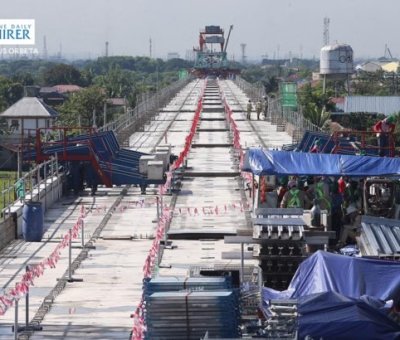By: Ben O. de Vera, Tyrone Jasper C. Piad – @inquirerdotnet
Philippine Daily Inquirer / 05:35 AM July 27, 2022
A day after President Ferdinand Marcos Jr. mentioned an infrastructure push by his administration during his State of the Nation Address (Sona), the Department of Transportation (DOTr) on Tuesday said it would resubmit three railway projects, whose loan agreements with China were earlier withdrawn by the government, to the state planning agency National Economic and Development Authority (Neda) for approval.
Transportation Undersecretary for Railways Cesar Chavez told reporters during the Marcos economic team’s post-Sona briefing that they were letting Neda, along with the Department of Finance (DOF), to decide how these projects’ funding would proceed under the new regime, either through official development assistance (ODA) loans or the public-private partnership (PPP) scheme.
Funding negotiations for the three projects, which were approved by Neda to receive ODA loans from China, began in 2018. The DOTr had even procured and awarded contracts for the engineering, procurement, construction and commissioning of the Subic-Clark railway project; the design-build of the Philippine National Railways south long-haul project to Bicol, and the project management consultant of the Mindanao railway plan.
The finance department, however, informed China Eximbank that the loan applications for the three projects would be valid only until May 31, 2022, and would be automatically withdrawn if not approved by then. The Chinese lender failed to act on the loan applications.
“The intention of [Transportation Secretary Jaime Bautista] is to resubmit the three of them. We will leave it to the economic team (on what funding scheme would be prioritized),” Chavez said.
“The best is still ODA,” he added, as it would be cheaper compared to the PPP route.
Finance Secretary Benjamin Diokno, President Marcos’ chief economic manager, said they might also consider financing from other bilateral partners such as Japan, as well as multilateral lenders Asian Development Bank and World Bank.
Viable option
At this point, Diokno said what was clear was that these big-ticket railway projects would be pursued by the Marcos administration.
Terry Ridon, Infrawatch PH convener, told the Inquirer that the government “should be able to pick and choose the most competitive rates from various funders while ensuring social and environment commitments with its development partners.”
Still, Ridon said he was unsure if the finance department was keen on incurring more loans during the pandemic.
“We have doubts on whether Malacañang and its economic team have the appetite to undertake new loans given the current limited fiscal space, particularly with rising interest rates around the world,” he said.
As of end-March, the country’s debts as a share of the gross domestic product (GDP) rose to 63.5 percent, the highest since the 65.7 percent in 2005. Higher debt-to-GDP ratio may put pressure on the country’s ability to pay back its obligations.
The Infrawatch convener, however, agreed with the DOTr that PPP might be the way to go.
“PPPs may be a viable alternative but only for projects with a clear business case for the private sector to participate, such as tollways, railways and transport hubs in metropolitan areas,” he explained.
Albay Rep. Joey Salceda said the Bicol railway would “change the game for our industries in the Pacific Seaboard,” given that Albay is the most densely populated province in the area and host to Bicol International Airport.
Panay, Cebu hopeful
He added that the railway would be “the closest thing to connecting the House Speaker’s home region to Luzon via rail.” Speaker Martin Romualdez represents the first legislative district of Leyte.
“If we can connect Manila, Albay, and the Waray Region together through a network of transport infrastructure backboned by rail, we can accelerate development and economic interconnectivity between these regions,” Salceda said, adding that “Bicol railway will be the backbone of an emerging Bicol-Mimaropa-Waray economic axis.”
In Iloilo City, Panay Railways Inc. director and chief operating officer Cesar Capellan said he was hopeful that rehabilitating the Panay railways, which closed down in 1985, would become a reality under the new administration, although at a higher cost.
He told the Inquirer that Phase 1 of the railway’s rehabilitation alone would cost at least $1.5 billion as it would include buying the trains, construction, hiring of personnel, maintenance and relocation expense of residents along the rail lines, among others.
Capellan said there would be four phases in the rehabilitation project, which runs from Lapuz district in Iloilo City to Roxas City in Capiz, as well as extending the rail line to Iloilo International Port in Barangay Loboc-Lapuz in Iloilo City.
The revival of the Panay railway was among the infrastructure projects that the Marcos administration plans to pursue.
Capellan said the government might look into the PPP or build-operate-transfer options, with the latter on a 25 to 50-year operating time frame.
In Cebu, government leaders also hoped to see the fulfillment of the railway system and the BRT under the Marcos administration.
“I feel enthusiastic that he (Mr. Marcos) supports the BRT and the Cebu railway system. To address traffic congestion in Cebu, we need to implement a basket of solutions,” Cebu City Mayor Michael Rama said in a media interview.
“These initiatives are a step in the right direction for Cebu City. The President’s Sona gave us a clear path to what we wanted,” he added.
At least three past presidents had promised to put up a mass transportation project to improve the traffic situation in Cebu.
Gloria Macapagal-Arroyo, Benigno Aquino III and Rodrigo Duterte finished their terms that spanned a total of 21 years without carrying out either the Cebu BRT or the Cebu railway system.
—WITH REPORTS FROM JULIE M. AURELIO AND JOEY MARZAN

